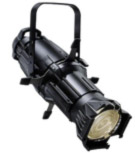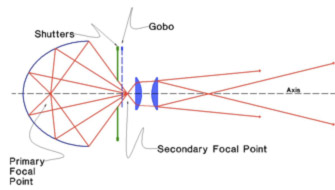Ellipsoidal Reflector Spotlight

Ellipsoidal Reflector Spotlight
The ellipsoidal reflector spotlight combines an ellipsoidal reflector usually with either one step lens or two plano-convex lenses “belly-to-belly”. In America, these fixtures are often referred to as “Lekos”, but that is actually the trade name of those ERSes manufactured originally by Century and subsequently by Strand. In the UK, they are referred to as “profile spots”.
Because the focal point of the lens system is just in front of the aperture (or gate), an image of anything placed in the gate will be projected by the lenses. Because the optics invert the projected image, it will appear to be upside down and backwards.
ERSes typically have four framing shutters, which are used to shape the beam of light. Because the projected image is inverted, pushing in the left shutter will cut off the right side of the beam, pushing in the top shutter will cut off the bottom of the beam, etc. A pattern inserted in the gate is called a “template” or “gobo”. Since the image is inverted, gobos must be inserted into the fixture upside down and backward.
 ERSes are useful when you want:
ERSes are useful when you want:
- A sharp edge
- A fixture which can be shuttered off scenery
- A fixture which can project a pattern, and/or
- High intensity
ERSes are typically available in fixed focal lengths, although zooms are available. “Fixed focal length” means that you can not significantly change the size of the beam other than by moving the fixture nearer or farther, shuttering it, or using a gobo. ERSes are usually described in one of two ways:
By the lens(es) used in the fixture (“6×9”, “6×12”, etc.), or
By their approximate field angle (40º, 19º, etc.)